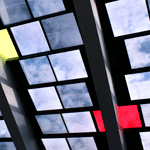When we see solar collectors on buildings, we feel good. We think happy thoughts about renewable energy and sustainability and a greener future. But the designers and engineers at Onyx Solar know this reaction may wane as smart-energy buildings proliferate. So the company custom-manufactures building-integrated photovoltaics (BIPV), which allow architects to incorporate solar into almost any flat surface.
Pros
+ In situ power generation via PV installations is possible on traditional as well as unorthodox surfaces of the building, walkways, and even parking areas.
+ Building orientation, including window placement, is driven by factors other than sun exposure.
+ Aesthetic goals of the building design can take higher priority since the architect won’t be burdened with the need to position rooftop-only PVs toward the sun.
Cons
– The cost. This is specialty manufacturing.
– BIPVs—including stick-on laminates, solar shingles, PV glazing of window glass, solar tiles—can overheat, which causes technical problems. Onyx Solar uses ventilation to attempt to avoid this.
“We believe there are no limits,” says Alvaro Beltran, chief executive officer of Onyx, a global company with offices in New York, Spain, and Colombia. The company manufactures its PVs to be part of the surfaces that are being used for a project by adapting to both its functional and aesthetic needs.
“An Onyx Solar-patented PV floor can be applied on terraces, rooftops, pedestrian walkways, open spaces, commercial building [façades], and sidewalks,” Beltran says. “It has been tested to even support light vehicle transit.”
Onyx Solar uses a flexible, handcrafted method of high-tech manufacturing that can easily respond to the specifications of an architect’s design or fit into any project. In fact, the company promises that it can meet any client requirements and integrate its PVs into any type of building. “We can achieve with one high-tech and reliable product all the energy and aesthetic requirements for every one of our projects,” Beltran says.
One of those recent projects is Pfizer’s GENyO building in Grenada, Spain. In the project, Onyx Solar’s BIPV solutions were incorporated into a ventilated façade, reducing energy demands by 25 to 40 percent and preventing overheating in the building. Onyx has multiple successful installations around the world, including in a canopy over BART rapid transit stations in San Francisco and in multicolored and semi-translucent skylights in markets throughout Spain.

